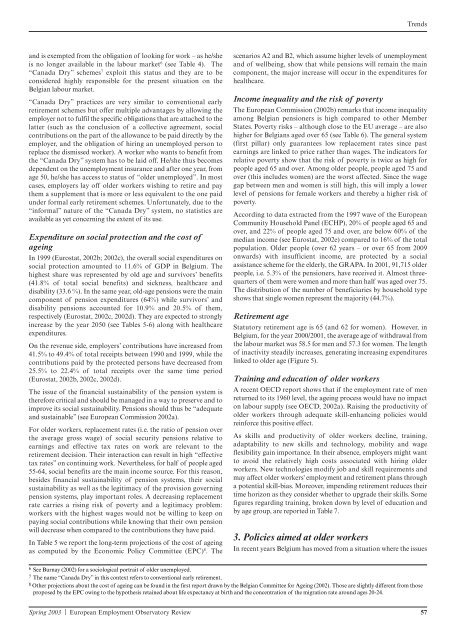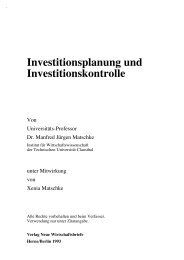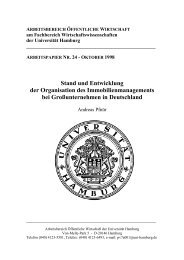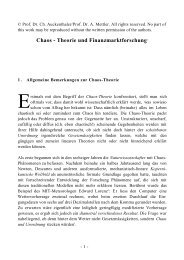FRANCE The
FRANCE The
FRANCE The
You also want an ePaper? Increase the reach of your titles
YUMPU automatically turns print PDFs into web optimized ePapers that Google loves.
and is exempted from the obligation of looking for work – as he/she<br />
is no longer available in the labour market6 (see Table 4). <strong>The</strong><br />
“Canada Dry” schemes7 exploit this status and they are to be<br />
considered highly responsible for the present situation on the<br />
Belgian labour market.<br />
“Canada Dry” practices are very similar to conventional early<br />
retirement schemes but offer multiple advantages by allowing the<br />
employer not to fulfil the specific obligations that are attached to the<br />
latter (such as the conclusion of a collective agreement, social<br />
contributions on the part of the allowance to be paid directly by the<br />
employer, and the obligation of hiring an unemployed person to<br />
replace the dismissed worker). A worker who wants to benefit from<br />
the “Canada Dry” system has to be laid off. He/she thus becomes<br />
dependent on the unemployment insurance and after one year, from<br />
age 50, he/she has access to status of “older unemployed”. In most<br />
cases, employers lay off older workers wishing to retire and pay<br />
them a supplement that is more or less equivalent to the one paid<br />
under formal early retirement schemes. Unfortunately, due to the<br />
“informal” nature of the “Canada Dry” system, no statistics are<br />
available as yet concerning the extent of its use.<br />
Expenditure on social protection and the cost of<br />
ageing<br />
In 1999 (Eurostat, 2002b; 2002c), the overall social expenditures on<br />
social protection amounted to 11.6% of GDP in Belgium. <strong>The</strong><br />
highest share was represented by old age and survivors’ benefits<br />
(41.8% of total social benefits) and sickness, healthcare and<br />
disability (33.6 %). In the same year, old-age pensions were the main<br />
component of pension expenditures (64%) while survivors’ and<br />
disability pensions accounted for 10.9% and 20.5% of them,<br />
respectively (Eurostat, 2002c, 2002d). <strong>The</strong>y are expected to strongly<br />
increase by the year 2050 (see Tables 5-6) along with healthcare<br />
expenditures.<br />
On the revenue side, employers’ contributions have increased from<br />
41.5% to 49.4% of total receipts between 1990 and 1999, while the<br />
contributions paid by the protected persons have decreased from<br />
25.5% to 22.4% of total receipts over the same time period<br />
(Eurostat, 2002b, 2002c, 2002d).<br />
<strong>The</strong> issue of the financial sustainability of the pension system is<br />
therefore critical and should be managed in a way to preserve and to<br />
improve its social sustainability. Pensions should thus be “adequate<br />
and sustainable” (see European Commission 2002a).<br />
For older workers, replacement rates (i.e. the ratio of pension over<br />
the average gross wage) of social security pensions relative to<br />
earnings and effective tax rates on work are relevant to the<br />
retirement decision. <strong>The</strong>ir interaction can result in high “effective<br />
tax rates” on continuing work. Nevertheless, for half of people aged<br />
55-64, social benefits are the main income source. For this reason,<br />
besides financial sustainability of pension systems, their social<br />
sustainability as well as the legitimacy of the provision governing<br />
pension systems, play important roles. A decreasing replacement<br />
rate carries a rising risk of poverty and a legitimacy problem:<br />
workers with the highest wages would not be willing to keep on<br />
paying social contributions while knowing that their own pension<br />
will decrease when compared to the contributions they have paid.<br />
In Table 5 we report the long-term projections of the cost of ageing<br />
as computed by the Economic Policy Committee (EPC) 8 . <strong>The</strong><br />
Spring 2003 | European Employment Observatory Review 57<br />
Trends<br />
scenarios A2 and B2, which assume higher levels of unemployment<br />
and of wellbeing, show that while pensions will remain the main<br />
component, the major increase will occur in the expenditures for<br />
healthcare.<br />
Income inequality and the risk of poverty<br />
<strong>The</strong> European Commission (2002b) remarks that income inequality<br />
among Belgian pensioners is high compared to other Member<br />
States. Poverty risks – although close to the EU average – are also<br />
higher for Belgians aged over 65 (see Table 6). <strong>The</strong> general system<br />
(first pillar) only guarantees low replacement rates since past<br />
earnings are linked to price rather than wages. <strong>The</strong> indicators for<br />
relative poverty show that the risk of poverty is twice as high for<br />
people aged 65 and over. Among older people, people aged 75 and<br />
over (this includes women) are the worst affected. Since the wage<br />
gap between men and women is still high, this will imply a lower<br />
level of pensions for female workers and thereby a higher risk of<br />
poverty.<br />
According to data extracted from the 1997 wave of the European<br />
Community Household Panel (ECHP), 20% of people aged 65 and<br />
over, and 22% of people aged 75 and over, are below 60% of the<br />
median income (see Eurostat, 2002e) compared to 16% of the total<br />
population. Older people (over 62 years – or over 65 from 2009<br />
onwards) with insufficient income, are protected by a social<br />
assistance scheme for the elderly, the GRAPA. In 2001, 91,715 older<br />
people, i.e. 5.3% of the pensioners, have received it. Almost threequarters<br />
of them were women and more than half was aged over 75.<br />
<strong>The</strong> distribution of the number of beneficiaries by household type<br />
shows that single women represent the majority (44.7%).<br />
Retirement age<br />
Statutory retirement age is 65 (and 62 for women). However, in<br />
Belgium, for the year 2000/2001, the average age of withdrawal from<br />
the labour market was 58.5 for men and 57.3 for women. <strong>The</strong> length<br />
of inactivity steadily increases, generating increasing expenditures<br />
linked to older age (Figure 5).<br />
Training and education of older workers<br />
A recent OECD report shows that if the employment rate of men<br />
returned to its 1960 level, the ageing process would have no impact<br />
on labour supply (see OECD, 2002a). Raising the productivity of<br />
older workers through adequate skill-enhancing policies would<br />
reinforce this positive effect.<br />
As skills and productivity of older workers decline, training,<br />
adaptability to new skills and technology, mobility and wage<br />
flexibility gain importance. In their absence, employers might want<br />
to avoid the relatively high costs associated with hiring older<br />
workers. New technologies modify job and skill requirements and<br />
may affect older workers' employment and retirement plans through<br />
a potential skill-bias. Moreover, impending retirement reduces their<br />
time horizon as they consider whether to upgrade their skills. Some<br />
figures regarding training, broken down by level of education and<br />
by age group, are reported in Table 7.<br />
3. Policies aimed at older workers<br />
In recent years Belgium has moved from a situation where the issues<br />
6 See Burnay (2002) for a sociological portrait of older unemployed.<br />
7 <strong>The</strong> name “Canada Dry” in this context refers to conventional early retirement.<br />
8 Other projections about the cost of ageing can be found in the first report drawn by the Belgian Committee for Ageing (2002). Those are slightly different from those<br />
proposed by the EPC owing to the hypothesis retained about life expectancy at birth and the concentration of the migration rate around ages 20-24.

















